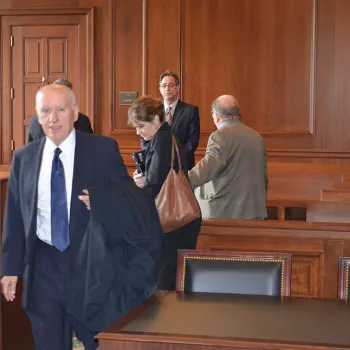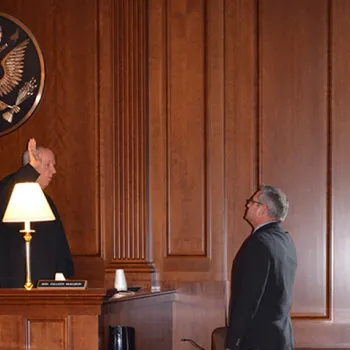Sandy was a powerful reminder of just how fragile we are, and I am extremely grateful to our court's employees and to our partners at the AO and GSA.
—Hon. Loretta Preska
By the Hon. Loretta Preska, Chief Judge, Southern District of New York
Note: In late October and early November, courts in New York, New Jersey and other Eastern Seaboard states were shut down by Super Storm Sandy. This account, by Chief Judge Loretta A. Preska, describes the challenges faced by the Southern District of New York, based in Lower Manhattan, in putting its courts back in order.
Judges work hard to ensure that the wheels of justice turn quickly, but their efforts may be thwarted when disaster strikes. On October 29, when Hurricane Sandy hit New York City and devastated the Lower Manhattan neighborhood, the Southern District of New York (SDNY) faced the threat of a lengthy shutdown. Fortunately for us, thorough preparation and constant communication saved the day. The court was able to conduct emergency hearings in lower Manhattan just one day after the storm hit and resumed full operations a week later.
The hurricane's severity became apparent the day before it hit, when Governor Cuomo shut down public transit inside and outside New York City. Bridges and tunnels in and out of Manhattan also were later closed. With no transportation to carry jurors or employees to the courthouse, we decided to close the court.
When the storm hit the city the next day, all of Lower Manhattan lost power. Through our emergency generators, the building went on emergency lighting. Most of the 26-story Daniel Patrick Moynihan U.S. Courthouse went dark—we had only 3 working elevators out of 26, no heating, and no hot water. Staff who came into the court just a day after the storm ran up and down darkened stairwells to communicate with one another. They worked on computers powered by extension cords that snaked around the office, and wore coats and scarves inside the chilly building. While the Court's internal phone system was working, we were unable to make outside calls because heavy flooding had damaged the major phone carriers' networks in Lower Manhattan.
However, the SDNY is no stranger to such challenges, and we are thankfully prepared to operate in times of crisis. Indeed, if there is one lesson that Sandy affirmed, it is that a good game plan is critical. After the September 11 attacks, we established a Continuity of Operations Plan (COOP) that guided us through the many logistical details of keeping courts running in a crisis.
Even before the storm landed, our court COOP team, led by District Court Executive Edward Friedland, started making preparations for continued court operations. When Sandy struck, our COOP team was on site at the Manhattan courthouse. Over the next week, they worked with a wide range of players: building management to restore operations; local utility companies, to check the status of power to the courthouse, as well as areas where employees and jurors lived; phone and internet service providers, to ensure that local circuits were restored; the United States Postal Service, to discuss the restoration of mail service; the City of New York, to discuss ongoing emergency management operations; and the transit authority, to discuss the restoration of vital public transportation.
I also asked our COOP team to reach out to other federal courts in Manhattan to see if we could assist them in any way. Working with the SDNY Bankruptcy Court, we established bankruptcy operations in the Moynihan Courthouse, at 500 Pearl Street, once power was restored there.
The COOP contained samples of several orders that were filed after Sept. 11, extending the deadlines for civil and criminal cases under the Federal Rules. Using these as a template, I issued similar orders in the wake of Sandy; we posted them on the court's website and distributed them to the media for publication. This cleared the decks for truly urgent proceedings to take place at the power-limited courthouse, and it gave litigants—and judges—some breathing room. Some operations, like criminal presentments and some docketing, were moved to our suburban White Plains courthouse, which was undamaged.
In addition to the COOP, excellent communication and teamwork played a key role in quickly restoring courthouse operations: Our COOP team kept judges, staff and jurors informed via phone calls, e-mails, and the internet. Our InfoWeb Emergency Notification System made it possible for some COOP managers (such as our Chief Probation Officer) to notify employees about court closures directly, either through employees' email or cell phone text messages. When the court's administrators discovered that AT&T's server had failed because the company's emergency generator ran out of fuel (and that our own internal server was intact), we failed over to our previously established local phone numbers and our national toll-free number; our Electronic Case Filing server was offline for only three hours at the height of the storm before we were able to put a read-only version of it online.
With so many factors out of our control, our COOP team had to be ready to restart court operations with or without some essential services. Staff from the District Court Executive's Office worked with GSA to add full courtrooms to the emergency generator. Other staff worked with the Post Office to reroute mail for both the District and Bankruptcy Court, and yet other staff set up private transportation that would be ready to shuttle judges, employees, jurors, and litigants from designated pick-up locations to the courthouse. We worked closely with our building engineer to ensure that we had sufficient fuel in our emergency generator each day to keep the building running. This meant coordinating with the U.S. Marshals Service to ensure that we could get fuel deliveries over closed bridges. The Administrative Office (AO) and the General Services Administration (GSA) were especially helpful to us, sharing their expertise and resources whenever they were needed.
As a result of everyone's cooperation, we held two hearings in Manhattan the week of the storm: a bail hearing in a case involving an alleged fraud scheme and an order to show cause hearing in an international abduction case. Judges and litigants sat in dimly lit courtrooms, used small table lamps to light their reading, and walked down darkened, empty hallways to get from chambers and lobbies to court. Because of the lack of transportation and widespread power outage, my own proceeding—a retrial of an attorney who was accused of helping Refco Inc.'s executives defraud investors of $2.4 billion—was put on hold, and I was able to focus on the business of getting the court up and running. In fact, I did little case-related work the entire week after the storm, even though I was still quite busy checking on judges, coordinating with the AO and GSA, getting food for the skeletal staff who made their way into work, and making numerous operational decisions.
However, the court's woes were minuscule compared to Sandy's bigger picture. Many court employees lost everything in the storm—homes and even entire neighborhoods were destroyed. Other employees had elderly family members who lived near the courthouse and could not evacuate; the staff who did make it to the courthouse delivered food to them on their way home. Once transportation service was restored in New York City, we had to be sensitive to the community around us and held off on summoning new jurors for a few extra days, giving people time to reestablish some semblance of a routine. And we were not the only courthouse where justice faltered in the wake of Hurricane Sandy—halls of justice up and down the East Coast faced the same challenges that we did, and with fewer resources.
Sandy was a powerful reminder of just how fragile we are, and I am extremely grateful to our court's employees and to our partners at the AO and GSA; they are incredibly capable, resilient people. Their efforts made the difference between justice having a small hiccup and grinding to a halt altogether.
Subscribe to News Updates
Subscribe to be notified when the news section is updated.




